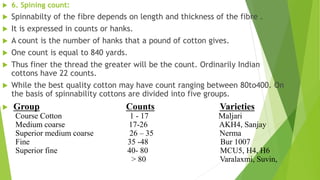This document provides information about cotton, including its scientific name, species, distribution, origin, varieties, botany, climatic requirements, cultivation practices, quality parameters, and yields. The key points are:
- Cotton belongs to the genus Gossypium, with four main species cultivated around the world.
- India is a major producer and cultivator of cotton, growing multiple species across states like Maharashtra, Gujarat, and Andhra Pradesh.
- Cotton requires warm temperatures and can grow in various soil types as long as pH is between 5.5-8.5.
- Quality is determined by parameters like ginning percentage, fiber length, fineness, strength, and spinning count.





















![7. Hygroscopicity:
The dry cotton absorbs moisture from the atmosphere.
Presence of moisture in the lint affects the colour, elasticity, lustre etc., and
the fibres having moisture break very frequently.
Thus the fibres which absorbs less moisture are considered to be of superior
quality and vice-versa.
8. Seed Index:
It is the test weight , which is weight of 100 seeds (g).
Seed index of cotton varies from 4.8 to 11g.
9. Oil content:
It varies from 14.5 to 22.5% is desi cotton and ranges between 17.5 to 22.5 %
in American cottons.
10. Lint Index: It is the weight of lint form 100seeds
Lint Index = [Weight of 100 seeds/(100 –G.P)] x GP](https://image.slidesharecdn.com/cotton-230111064935-f21ccb8f/85/COTTON-pptx-22-320.jpg)
